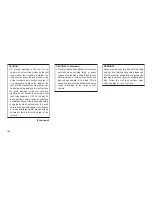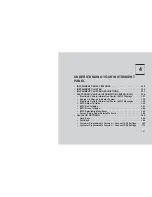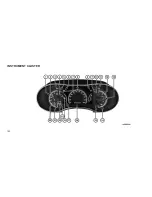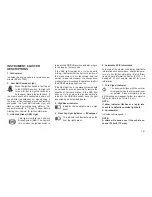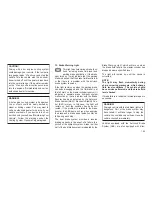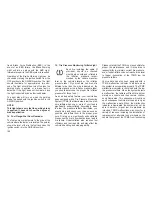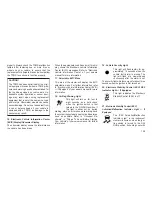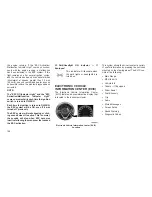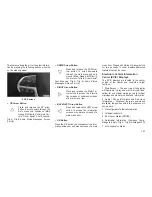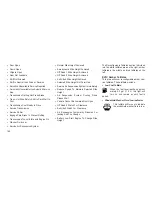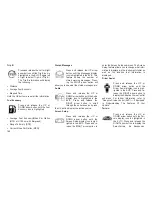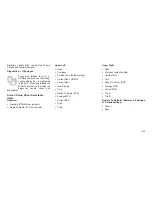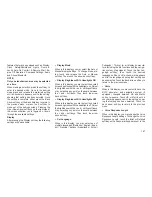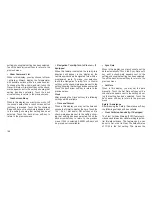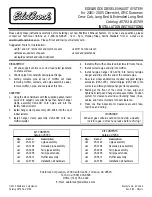
tronic Brake Force Distribution (EBD). In the
event of an EBD failure, the Brake Warning
Light will turn on along with the ABS Light.
Immediate repair to the ABS system is required.
Operation of the Brake Warning Light can be
checked by turning the ignition switch from the
OFF position to the ON/RUN position. The light
should illuminate for approximately two sec-
onds. The light should then turn off unless the
parking brake is applied or a brake fault is
detected. If the light does not illuminate, have
the light inspected by an authorized dealer.
The light also will turn on when the parking
brake is applied with the ignition switch in the
ON/RUN position.
NOTE:
This light shows only that the parking brake
is applied. It does not show the degree of
brake application.
14. Fuel Gauge/Fuel Door Reminder
The fuel pump symbol points to the side of the
vehicle where the fuel door is located. The pointer
shows the level of fuel in the fuel tank when the
ignition switch is in the ON/RUN position.
15. Tire Pressure Monitoring Telltale Light
Each tire, including the spare (if
provided),
should
be
checked
monthly when cold and inflated to
the
inflation
pressure
recom-
mended by the vehicle manufac-
turer on the vehicle placard or tire inflation
pressure label. (If your vehicle has tires of a
different size than the size indicated on the
vehicle placard or tire inflation pressure label,
you should determine the proper tire inflation
pressure for those tires.)
As an added safety feature, your vehicle has
been equipped with a Tire Pressure Monitoring
System (TPMS) that illuminates a low tire pres-
sure telltale when one or more of your tires is
significantly under-inflated. Accordingly, when
the low tire pressure telltale illuminates, you
should stop and check your tires as soon as
possible, and inflate them to the proper pres-
sure. Driving on a significantly under-inflated
tire causes the tire to overheat and can lead to
tire failure. Under-inflation also reduces fuel
efficiency and tire tread life, and may affect the
vehicle’s handling and stopping ability.
Please note that the TPMS is not a substitute for
proper tire maintenance, and it is the driver’s
responsibility to maintain correct tire pressure,
even if under-inflation has not reached the level
to trigger illumination of the TPMS low tire
pressure telltale.
Your vehicle has also been equipped with a
TPMS malfunction indicator to indicate when
the system is not operating properly. The TPMS
malfunction indicator is combined with the low
tire pressure telltale. When the system detects
a malfunction, the telltale will flash for approxi-
mately one minute and then remain continu-
ously illuminated. This sequence will continue
upon subsequent vehicle start-ups as long as
the malfunction exists. When the malfunction
indicator is illuminated, the system may not be
able to detect or signal low tire pressure as
intended. TPMS malfunctions may occur for a
variety of reasons, including the installation of
replacement or alternate tires or wheels on the
vehicle that prevent the TPMS from functioning
154
Summary of Contents for Grand Cherokee SRT 2014
Page 1: ......
Page 3: ......
Page 4: ......
Page 6: ...2...
Page 11: ...7...
Page 68: ...64...
Page 154: ...INSTRUMENT CLUSTER 150...
Page 203: ...Control Setting Suggestions for Various Weather Conditions 199...
Page 204: ...200...
Page 276: ...272...
Page 330: ...326...
Page 331: ...8 MAINTENANCE SCHEDULES MAINTENANCE SCHEDULE 328 327...
Page 332: ...MAINTENANCE SCHEDULE Refer to the Service and Warranty Handbook for maintenance schedules 328...
Page 333: ...9 IF YOU NEED CONSUMER ASSISTANCE IF YOU NEED ASSISTANCE 330 329...
Page 335: ...331...
Page 336: ...332...
Page 337: ...10 INDEX 333...







